
The article below was written by Christopher Heaps. Heaps is a Sellwood resident who rides his bike daily to his job as a lawyer with Stoel Rives in downtown Portland.
You might remember Heaps as the lawyer who garnered a headline or two for successfully carrying out the “citizen-initiated citation” process. We wrote about Heaps earlier this month because he’s representing two men who feel they were wrongly cited in the Ainsworth Incident.
In the article below, Heaps shares his thoughts on why he thinks Portland should adopt a new safe passing ordinance.
Portland Needs a Safe Passing Distance Ordinance
By now you’ve probably read about the Ainsworth Incident, in which Portland Police Bureau Officer Jimmy Pryce passed a cyclist “within a foot” of their handlebars while driving his police car. Several important issues were raised by this incident, but perhaps the most fundamental — for those of us making our way around Portland on two wheels every day — is, “Isn’t this a violation of Oregon law?”

by Multonomah County.
Being a lawyer (disclaimer: I am also representing the cyclists in the aforementioned incident), I want to make clear that I’m not giving any legal advice here, I’m merely expressing my opinion that operating a motor vehicle so as to cause it to pass within a foot of a bicyclist’s handlebars is indeed a violation of Oregon’s Vehicle Code.
So … what’s the violation?
The first place you might look is the legislation passed in 2007 that led to Oregon Revised Statute (ORS) 811.065 (see this page for all the statutes referenced in this article). That law provides for a traffic offense known as “unsafe passing of a person operating a bicycle.” It requires drivers to pass bicyclists at a “safe distance,” and defines the term “safe distance” to mean
“a distance that is sufficient to prevent contact with the person operating the bicycle if the person were to fall into the driver’s lane of traffic.”
That sounds exactly like what Officer Pryce is alleged to have done, right?
Unfortunately, the law contains a broad exception that applies on virtually all streets where bicyclists ride, making the law – in my humble opinion – virtually worthless. A driver cannot commit the traffic violation of “unsafe passing of a person operating a bicycle” if the driver is going 35 mph or less. Yes, really.
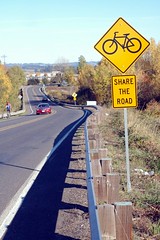
law applies only to rural roads
with speeds over 35 mph, like
this one in North Plains.
(Photos © J. Maus)
Simply put, it makes no sense that this exception is in the law. As I mentioned, the speed limit will be 35 or less virtually everywhere bicyclists ride. The law is only applicable on rural roads, and Portland doesn’t have any of those. This law does not help Portland’s bicyclists at all. Nor does is help anyone riding virtually anywhere in any of Oregon’s towns.
We all know speed is dangerous. One could argue that it’s not as dangerous to pass a bicyclist within the prescribed distance when going slower than 35 mph. But, as anyone who rides around our fair City (or any other) can tell you, it’s dangerous to pass someone that closely even at 15 mph. It’s so close that even the slightest miscalculation or unforeseen event could cause the bicyclist’s death or severe injury.
So, why shouldn’t this infraction apply regardless of speed?
I’ve asked this question of some people who are familiar with the legislative history of this rule, and I was told that it is the product of a political compromise in which TriMet felt that its bus drivers should not be required to give bicyclists this much room when passing them*.
[*Editor’s note: In a story published here two years ago, a TriMet spokesperson expressed concerns about a passing distance law in downtown “where streets are very narrow.”]
“If we really want to encourage people to get on their bikes and ride around Portland … we need a specific standard that everyone can understand, a standard that protects bicyclists from the risk of being killed by people trying to save a few seconds on their drive.”
In addition, it’s very difficult to prove how fast a driver was actually going without the benefit of police radar. That means it’s virtually impossible to cite a driver for this violation without the benefit of a speed trap. The rule requiring safe passing should not require proof of the motor vehicle’s speed. Further, it should be based on a clear standard for what distance is far enough (such as the “fall-over” standard in ORS 811.065).
When I first started riding on the streets of Seattle and a motorist gave me a very close pass, I was terrified. I considered never riding on the roads again. It frightened me so much because I knew I could have been killed instantly. And there are only two reasons drivers do this; either they’re oblivious to the risk they’ve created or they’re trying to send that very message to you. That message is, get out of my way and stay off the roads so you don’t slow me down.
Do we want our laws to help those few dangerous drivers to send that message?
Now, if you’re thinking about the Ainsworth Incident, you’re asking, “Was Officer Pryce going 35+ mph?” To answer that question you first have to ask: What evidence of his speed is there? As I mentioned above, it’s a difficult thing to prove. And knowing Officer Pryce’s speed isn’t important to the point of this editorial anyway. One point is that ORS 811.065 is of limited value – the proverbial bone thrown to a few concerned activists (thank you!) who showed up in Salem and told stories about how people riding on rural roads were killed by aggressive drivers trying to pass them.
ORS 811.065 does nothing to address the numerous, and often unreported, incidents that occur in Portland every day when drivers attempt to unsafely pass bicyclists.
So, are there any other candidates for dealing with this dangerous behavior? Yes. ORS 811.420 prohibits passing in a no passing zone. Many of us have experienced drivers passing us this way, whether it be on blind hills on the west side of Portland, on a curve out in the Gorge, or within only a few feet of an intersection around town. Unfortunately, this offense doesn’t specifically address close passing.
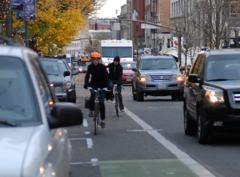
a more broad safe passing distance
law from being enacted.
Also, the “unsafe passing on the left” violation in ORS 811.410 requires vehicles to pass “at a safe distance.” Unfortunately, what constitutes a safe distance under this rule is not defined. That means it will be left for the judge to decide what the distance actually was – does he or she believe the police officer or the bicyclist? And, regardless of who she goes with on the facts, was that distance “safe”? Has the judge been on a bike since she was 5 years old? Can she understand what it’s like to have two tons of metal bearing down on you while you’re pedaling next to parked cars?
The judge’s predilections aside, it seems clear to me that passing within a foot of someone’s handlebars violates ORS 811.410.
The only other candidate Oregon law offers us is “careless driving,” (ORS 811.135). A driver is driving carelessly if he/she drives, “in a manner that endangers or would be likely to endanger any person or property.” Is passing within a foot of someone’s handlebars an act that endangers them? Again, it seems obvious to me that it is. But, there is no bright line in the law. So, we’re faced with the same issue of judicial discretion.
Right now, it seems that ORS 811.410 (vehicles required to pass “at a safe distance”) and 811.135 (careless driving) are all we’ve got. Do you really want to have to rely on being subjected to this sort of terror and then going to court and getting a good (ahem) lawyer to argue that what the driver did was so dangerous and irresponsible as to be illegal? Or, would you like to have a clear standard that everyone can understand? A standard like: Don’t come within 5 feet of me with your car under any circumstances.
It seems to me that, if we really want to encourage people to get on their bikes and ride around Portland – and that’s what I want – we need a specific standard that everyone can understand, a standard that protects bicyclists from the risk of being killed by people trying to save a few seconds on their drive.
You might be surprised to learn one city in Oregon has done this. You might be even more surprised to learn that it’s Grants Pass. Yep. Thanks to the work of attorney Mark Lansing and some dedicated roadies down in southern Oregon, Section 6.20.220 of the Grants Pass Municipal Code requires drivers to give bicyclists three feet of distance when passing. Pretty great, right? Five feet would be better, but still – it’s clear.
During our recent City elections, I supported two candidates (Jim Middaugh and Chris Smith) who were not elected to the City Council. I spoke with both of them about creating a city ordinance that incorporated the standard in 811.065, providing that it is unsafe and illegal to pass a bicyclist – at any speed – at less than “a distance that is sufficient to prevent contact with the person operating the bicycle if the person were to fall into the driver’s lane of traffic.” Both of them liked the idea. I think most, if not all, of our current City Commissioners would too.
If our City leaders truly want to encourage people to ride around town, they can do something very simple to remove one important daily source of fear and frustration for Portland’s bicyclists, not to mention something that will perhaps provide a key source of education for Portland’s police officers. They can enact an ordinance that tells motorists, plain and simple, to give bicyclists room.
I’m considering gathering names for a petition to our City Commissioners about this issue. What do you think? Would you join me in asking our City Council to adopt a clear and enforceable safe passing distance ordinance?


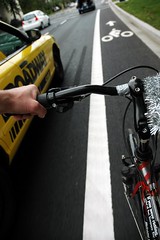
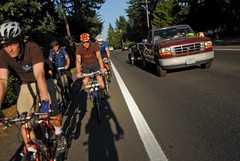
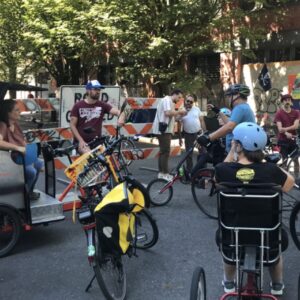


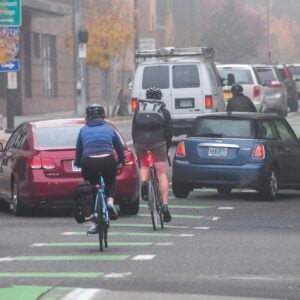
Thanks for reading.
BikePortland has served this community with independent community journalism since 2005. We rely on subscriptions from readers like you to survive. Your financial support is vital in keeping this valuable resource alive and well.
Please subscribe today to strengthen and expand our work.
Thanks for your thoughtful input on this! Indeed, there is a lot of (often) frustrating ambiguity in the law.
I have repeatedly mentioned 811.065 here on BikePortland. Don’t forget 811.060 either. I was not aware that there were provisions exempting urban drivers, nor was I aware of the speed component exemption. I’ve researched these two statutes extensively and had never noticed these provisions. Incidentally you lose this protection regardless of speed and location the second you enter a bike-lane.
After speaking with authorities on numerous occasions about enforcement of these two statutes I was always told they were simply unenforceable. The problem being that which you’ve outlined above. We do prosecute all kinds of crimes and violations though, based solely upon the, “Word”, of the victim. Why not these?
I am so glad someone brought this subject up again. While Portland needs this law, really the entire state does. How can we get the state to relook at the this and create something that is clear enough for everyone to understand?
The BTC http://www.washcobtc.org would be very interested in changing the law for the entire state of Oregon. What if a motorist passed a pedestrian with inches to spare?
Make sure to include the BTC and the BTA in your legislative efforts.
I think it would be wonderful to have the speed restriction removed from that part of the law, that would definitely alleviate some nervousness riding in with automobile traffic. I think though, if it gets changed, an equally important part of the process would be to let people know that the rule exists – advertising in popular media letting people in Portland know what the restrictions of that law are. If people don’t know a law exists, they won’t follow it, and I don’t ever remember being told in drivers’ ed classes that I had to give bicyclists room.
The other big thought that this whole issue brings to mind for me is – *segregated modes of transport*. This would be much less of an issue if at least some of the major bike routes through town had segregated bike paths. I think if you want to be a “world-class biking city” you just have to bite the bullet and do it at some point. We don’t need it on the scale of Copenhagen or Amsterdam (that is, almost never having to ride in with car traffic), but at least having it on some of the highest traveled routes would be nice.
I would sign a petition.
ORS 811.065 could use some clarification or/and specifics about speed and distance relative to the passing of bikes by motorists, that’s for sure. A distance of at least ‘arm’s length’….3 feet, seems reasonable for passing speeds of 15 mph. Distance should increase accordingly, with increased speed, up to the width of a full lane.
A lot of road users seem to have the common sense to figure this out on their own, and if they’re passing at a 15mph or more speed differential, will give a bike 5′ or more distance. Unfortunately, many road users don’t. For them, greater specification in a law is probably necessary.
The bit about consideration for the buses needing to pass bikes on narrow streets being a factor in the 35mph speed designation of the ordinance: that seems like far too much latitude. Some bus drivers will use it with great discretion, passing at speeds of 10 mph or less when the distance is 3′ or less, but even I’ve frequently seen buses swiftly approach and pass bikes at distances less than 3’. Under those circumstances, even when you know they’re coming, it’s not a safe feeling.
“And there are only two reasons drivers do this; either they’re oblivious to the risk they’ve created or they’re trying to send that very message to you. That message is, get out of my way and stay off the roads so you don’t slow me down.” Heaps
Also, I think overconfidence figures into this situation. Some people consider themselves excellent drivers, to the extent that they feel able to safely pass a bike very closely at excessive speed. This kind of driving conduct doesn’t take unforeseen consequences into consideration, such as unnecessarily startling, traumatizing, or causing another road user to lose control of their vehicle.
yes.
Perhaps we could support/demonstrate the necessity of the law by using spacers…
http://www.fahrradteile.com-onlineshop.com/onlineshop/product_info.php/cPath/632_165/products_id/2908
Whatever message close-passing drivers are trying to send, the message the rest of the world is receiving is: I’m so selfish that my three seconds of convenience are worth more than your life.
We need stronger laws to get pathological drivers like this off the road, not just for bikers but for the sake of anyone else — drivers, pedestrians — who gets in their way.
I think the City of Portland is much more likely to get an ordinance like this passed before the Oregon Legislature gets around to a statewide law. Also, the city is already working on cycle tracks (see the article on BikePortland.org on November 20th).
I like the idea of a minimum fixed distance to establish a reasonable safe passing distance. How about 6 feet? Get the petition going!
In Oregon, cars passing a pedestrian typically have to allow the pedestrian the lane s/he is walking in and the adjacent lane.
The shortest distance is in a controlled intersection with marked crosswalk. In that case, the driver must to wait until the pedestrian is at least six feet from the lane into which the driver’s vehicle is turning. ORS 811.028(D)(E)
That’s not when the pedestrian is six feet into the lane, it’s when the pedestrian is already out of the lane, and then another six feet away from the lane the driver wants to turn into. In California, for example, it’s a “safe distance.” You could even still be in the lane with the car. I prefer the Oregon law.
I think 3 feet is still too close for passing a bike. If you stick your arm out to signal a left turn, that’s already 3 feet. Sorry to the lanky out there, your arms must not longer than 3 feet to ride 😉
If we could tie safe bike passing distance to the 6 feet allotted to pedestrians it might be easier for people to remember.
I have ridden a bike in the Netherlands where the buses pass really close to the bikes. It’s scary both when riding a bike and to see it from a seat with a good view at the front of the bus, or even from the sidewalk. It’s especially scary during the daily rush hour.
At greatly reduced speeds, the combination of buses and bikes is much more manageable, and doesn’t turn into a snow plow or steam roller, but most of the Portland city speed limits are already way higher than the speed limits on the streets where you’d find buses nudging their way through the crowds of bikes in the Netherlands.
I really like this potential legislation. I think many drivers would be grateful for clarity here.
Take this hypothetical yet extremely common scenario: A cyclist with a line of cars behind. The first driver is creeping along at the cyclist’s speed looking for a gap to pass. This driver feels two (maybe more) conflicting concerns.
1) Concern for the cyclist
2) Concern for impeding the traffic behind
If the law is gray then the driver might feel pressure to pass as soon as it’s possible. The longer the wait the more risk a driver may be willing to take. There’s plenty of psychology going on in this scenario.
If a law exists and it is well publicized and enforced then the motorist has a simpler decision to make. It makes driving less stressful.
I’m using the motorist’s point of view because that’s who needs convincing. Surely all cyclists do not enjoy getting buzzed with inches to spare.
City wide, county wide, state wide, federal… If you get me a pedition, I’ll sign it, and vote for it.
This is something that everybody should get behind.
Add some honking into the scenario and you have tremendous pressure for both the car and the bike!
That’s why I like the space holders: Visually it give you a clue how much space the biker needs – one less thing to compute… specially during twilight!
I’d sign a petition.
Are those spacers, provided in the link within post #9, or similar ones available for purchase within Portland?
there is also an exception for passing a bike in a striped lane, yet another reason to get rid of the mandatory sidepath law. before coming to Portland, I worked with the St. Louis and Missouri state bike advocacy groups to get a safe passing distance statute enacted at the state level. we had to give up the “three foot” language in committee. would be happy to join this effort.
I support the idea. I would sign a petition. I would ask friends to sign up as well. I actually thought we had one and was considering making a sign like the person in this photo did in Illinois.
http://www.flickr.com/photos/willownaeco/2414693466/
Yes I would sign and support. I suspect PBOT would support same
I would support and sign such a petition if presented to me. My wife would sign one too!
Show me where to sign.
Last time I checked I was a resident of the City of Portland (if not, I want all those taxes back) and I ride every day on a road with a posted speed limit of 40 mph and no bike lane. Only parts of Portland earned that platnum rating. That being said, I would support adding specificity to the existing law. And I’d also support any kind of actual enforcement of the existing bike and pedestrian laws. Here’s a link to a bike jersey for those who want to wear their political statements: http://3feetplease.com/
The snapshot above with the share the road sign- it is a double yellow line- No passing. To give a bike 4 ft it looks like you would need to cross the yellow line, or slow down and follow the bike untill it pulls over to let you pass. perhaps this is not a good road for bikes to be on? especially younger riders.
Jim, the snapshot you’re referring to; that’s a rural situation. No doubt you also notice, that on the very long stretch of road visible in the snapshot, there’s only two cars and one bike traveling on it.
Particularly with that kind of traffic condition, a little common sense and reasonable patience should allow for a driver to easily and with very little delay, pass a person or number of persons on bikes, leaving a safe distance between the two different types of vehicle. There’s a number of ways to manage this, and for most people, common sense will be enough to direct them in terms of how to go about it.
For those to whom the way to go about it safely isn’t self explanatory, maybe some experienced instruction would be helpful.
If anything, passing a bike on a stretch of road like the one in the snapshot would probably be significantly easier than passing a slow moving farm vehicle or an RV on the same stretch of road.
i’d sign
What if we reverse the question? As a driver, something that makes me nervous is that when I am at a stop light (Or sometimes just in slow moving traffic) and a cyclist who is in the full lane rides to the right side of the lane and passes me on the right, while we are in essence sharing the lane. This doesn’t worry me so much when I am in the right hand most lane, but let’s say for example on Broadway, in the left most lane of two lanes. I’ve had cyclists in essence “Share” the lane with me. How would the law apply then? I’ve had my side mirrors hit by cyclists coming from behind me. I can’t control the passing distance there. In addition, it’s a really dangerous situation because 1) it’s not expected and 2) it’s so close that visibility isn’t good.
The time this most scared me was when I was driving straight through the intersection, moving slowly due to traffic, and a cyclist who was moving faster than traffic passed me on the right and turned left in front of me. If the timing had been just a little more off, I shudder to think what would have happened.
Anyway – what I’m describing above is something that I think should be considered when looking at passing distances… It’s important to consider it on both sides.
Thanks.
Question about the Grant’s Pass law: where do they measure the 3 ft from? Handlebars? Wheels? Head?
Here’s a discussion of the German law pertaining to the required distance automobiles must keep away when passing bicyclists. The standard distance is calibrated to correspond to the space required if the cyclist were to fall over (see language in the article above), which is certainly not three or even four feet for adults.
http://www.pdeleuw.de/fahrrad/urteile.html#seitenabstand
The German laws stipulate 1.5 meters, or just a hair less than 5 ft. And this distance increases to 2 meters (over 6-1/2 ft) if the car’s speed increase to 90km/h.
This page includes a bunch of interesting additional laws all related to pedestrians and bicyclists:
http://www.pdeleuw.de/fahrrad/urteile.html
Reuben Deumling
Drivers who buzz cyclists express their traffic-jam woes with an outlet that our society approves of. Being unable to vent grief against the obvious impediment to their travel speed (other cars), a person on a bike can be easily frightened and threatened by the frustrated motorist. All those car ads that guarantee the freedom of the open road turned out to be a lie, and some motorists will vent anger on the most vulnerable, which is the height of cowardice.
Our friends and neighbors are maimed or killed; the motorist “didn’t see him”, and the tragedy is swept under the rug. Meanwhile angry motorists lecture me on how dangerous it is to ride a bike. At the same time I sense their envy at my joy in being able to do something that would terrify them. They assume other drivers are just like them, and would just as soon mow them down with their cars without even getting a traffic citation.
Thank you so much Mr Heaps for working to making our society more civilised. It’s the wild west out there, but every step we can take to foster empathy and civility on the roadway will make things just that much better for those who inherit all that we work for. I would not only sign a petition, but would work to get another hundred signatures.
Anonymous #26, I think the point you raise is valid. It’s situations like you describe, primarily the first one, that could make a ‘safe distance’ law confusing for some road users, depending on exactly what it might specify. In the example you cite, it seems likely that the burden of responsibility for failing to maintain a safe distance would be on the person riding the bike, if something bad were to happen.
If road users got wind of an idea being proposed for a law that would require them to keep their motor vehicles ‘x’ amount of feet away from a bike while passing, would they argue in turn that it would only be reasonable if the same requirement were expected of people riding bikes in regards to passing motor vehicles?
Reuben…thanks for those links, but some of us aren’t so good with reading German…I’m one of them…an English translated page would be great!
“Has the judge been on a bike since she was 5 years old? Can she understand what it’s like to have two tons of metal bearing down on you while you’re pedaling next to parked cars?”- Chris H.
Nothing says Imminent danger more clear than having 2 tons of guided missile pointed at you.
I’ve had my left arm nearly broken on Virginia roads last summer. Riders there don’t have the option of taking the lane when there’s no shoulder. What happens when you are required to ride to the “right-most part of the lane”?
Nearly always there is enough room for a motorist to squeeze their Escalade through, regardless of the 2nd lane, OR oncoming traffic. My Experience with the mirror was the result of easing over less than 8″ to avoid a road edge hazard.
This Issue Is not new..here’s a link to a 2 year old story in Oregon Cycling Magazine, with an account of how Salem Cyclists addressed just ONE driver.
http://www.oregoncycling.org/2006/08/going-after-dangerous-neighborhood-cranks/
listed are other ORS statutes inc. Menacing, Eminent danger, and disorderly conduct, following to closely (for those jerks rthat like to pull up behind and honk, gun the engine, or otherwise make an ass out of themselves.)And finally-horn use limits.
Be sure and check out the update on the bottom of the page.
My attitude is, pass me close enough for my foot to crease your Quarter panel..
Dave in post 5 has it right. You need segregation to get a high cycling rate. You need it because the level of subjective safety will otherwise be too low for most people to ever ride a bike.
BTW, neither Amsterdam nor Copenhagen have really high rates of cycling. The top city is Groningen where 60% of all journeys are by bike. We live a little south of there.
I’ve not been passed too close by a vehicle since we moved here nearly two years ago.
Unfortunately, the Red Pickup guy about whom Steven J writes, #31, was acquitted because his actions didn’t really fit any of the charges that the DA brought. There is another ongoing effort to get him on reckless endangerment.
Jim, #23, a motorist can cross a double yellow line to get around an “obstruction” if doing so can be done safely. Many people consider bicycles as falling within “obstruction”, particularly on rural roads where the speed differential is significant.
Perhaps a Portland ordinance would eliminate TriMet’s unfortunate opposition to a state law and provide a more enforceable definition of a “safe passing distance”.
This is why the BTA exists.
While there are many groups promoting cycling as transportation, recreation, economic driver, or whatever, there is only one group that exists to advocate for legislative and governmental recognition of cycling and its role in our daily lives.. The BTA.
Their work is sometimes arcane,wonky or under the radar,but they have built solid relationships with law makers and law enforcement, as well as city and local governemnts.
For a long term effort.. has anyone contacted the BTA and seen if there is already a similar effort underway? IF so, what can BP readers do to support it?
IF not, is it something to explore?
In the province of Québec Canada, the rules are here:
http://www2.publicationsduquebec.gouv.qc.ca/dynamicSearch/telecharge.php?type=3&file=/C_24_2/C24_2.htm
Translation from French by me:
341 – Passing a bicycle: the driver of a motor vehicle shall not pass a bicycle within the same traffic lane unless there is sufficient space to do so without danger.
487 – Bicycle rider: with the exception of article 492, the bicycle rider must ride at the extreme right of the lane and in the same direction as traffic, unless this space is obstructed or if he is making a left turn. (492 only says that if there is a bike path, a cyclist _must_ use it.)
Looks like Portland is not alone in needing some exact numbers in these rules!
I would definitely sign a petition to city councilors for a better defined ‘safe passing distance’.
I find that many drivers who seem to be respectfully passing – giving plenty of space – will often do so in inappropriate circumstances. Most common example I see is the driver utilizing an OPPOSING lane, very close to or even passing an intersection! There is a real likelihood that a second driver could be turning right onto your road, properly entering the opposing lane, and risking a head-on with the driver passing the cyclist.
I see this A LOT on smaller, neighborhood streets.
There appears to be such a SENSE OF ENTITLEMENT where a motorist feels they have a right to maintain their speed. The risk of passing is involuntarily imposed upon the cyclist … irrespective of obvious or general safety compromises.
And don’t get me started on cell phones …
Anonymous @ 26.
The idea of a graduated safe distance is intuitive and already codified for cars, think about giving 1 car length for every 10mph.
So for bikes it makes perfect sense that as your speed decreases the amount of safe passing distance does also. If you’re in a car, downtown, traveling at 0 miles an hour(like at a light), that safe passing distance logically would be reduced to inches. If a motorist uses their turn indicators (inexplicably viewed as optional by way too many) and proceeds in an orderly fashion the risk is minimal.
This excuses someone turning left across your path no more than it excuses that Yukon buzzing me after dark when they have 4 feet between them and the centerline with no opposing traffic.
If by some strange circumstance I were passing your car at 35mph on my bike, you can bet I’d give you much more than 3ft, and yet the life at risk would still be mine.
I would sign such a petition…
I would like to see general reform of driver education in Oregon. Seems to me most drivers in Portland don’t know how to read the yellow line and it’s 4 variations, and no one younger than Karl Malden (big nose, The Streets of San Francisco) seems to have ever heard of the 2-second rule.
I was told by a Dutchman that in Holland when a car and bicycle collide, the law assumes driver culpability unless proven otherwise… don’t know if that’s true, but I’d like to see it here for peds and cyclists.
Robert (# 38): Yes, that is true. Not only here in the Netherlands, but in most of Northern Europe excepting the United Kingdom.
However, the big deal here is that cars are generally kept away from where they will cause problems for cyclists. Just asking drivers to give a bit of distance is relatively ineffectual by comparison.
I can’t thank you enough for putting you energy and know-how into this effort, which will benefit EVERYONE on the road, not just bikers!! ANYONE (besides a cop, since they’re automatically protected) would like to have a clear law stated if they were in court for a similar situation. It’s so sad to see a “bike-friendly” city defend their Police actions, even when they’re obviously acting very wrongly (according to the “protect and serve” oath).
I would happily sign a petition, donate some time, buy you a beer or cookie for your efforts etc…. I’m so glad someone out there is trying to get this taken care of. I just sell shoes and play guitar, or I’d help.
Bill-
While we are talking about cell phones can we get on the topic of drunk biking scenesters texting while pedaling?
People who do not drive carefully and responsibly are indeed a problem. But so are bicyclers who insist on getting un-necessarily and dangerously close to traffic. Seems to me that both sides of this issue could be more careful.
What would you consider “un-necessarily close”?